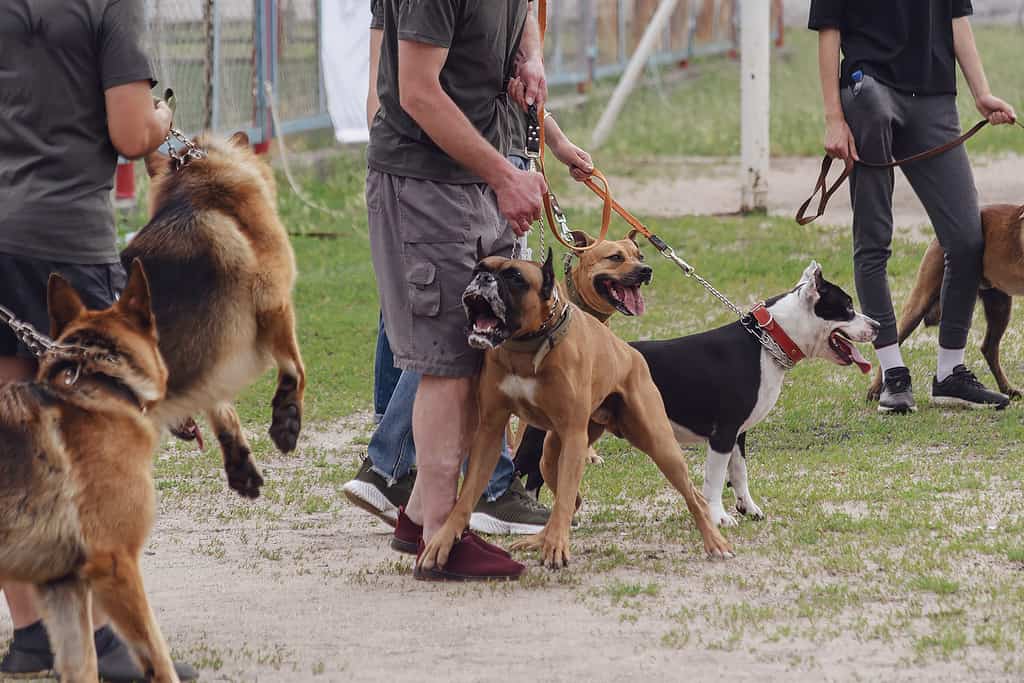Ear cropping is outlawed in several countries, including England, because it’s unethical and seen as animal cruelty. Unfortunately, it’s still allowed in all 50 U.S. states.
Ear crops for dogs are painful and make it more difficult for a dog to communicate with others. This unnecessary surgery is purely cosmetic, and it has a lifetime of negative impacts. Many dogs are traumatized after having their ears cropped.
In this article, we’ll go through everything you need to know about ear cropping, from why it’s done to its impacts on a dog.
What is Ear Cropping in Dogs?
Ear cropping in dogs is a cosmetic surgery that removes or alters a dog’s ears, according to the RSPCA.
Most commonly, ear crops make a dog’s ears stand upright in a pointed position. This is sometimes done just because a person thinks it looks better, but it’s more commonly done to make a dog look fierce or to show the dog in dog shows.
Sometimes, the ears are also taped or splinted. This is most commonly done for large breeds to keep the ears upright until they can stand on their own.

Most commonly, ear crops make a dog’s ears stand upright in a pointed position.
©iStock.com/f8grapher
Is Ear Cropping Dogs Ethical?
No. Ear cropping in dogs is a purely cosmetic procedure with no benefits for the dog, and thus it’s highly unethical.
Dogs with cropped ears (hopefully) undergo anesthesia, which comes with risks of its own. They then have painful recoveries, some of which will go wrong if the dog develops an infection or heals incorrectly.
If the procedure isn’t done by a licensed veterinarian, it is even more abusive, risky, and incredibly painful for the dog.
What are the Negative Effects of Ear Cropping?
Anesthesia Risks
While anesthesia is often safe, it’s not good for dogs to go under anesthesia when it’s not warranted. This is because there are inherent risks to it, which can include cardiac arrest, stroke, and even death in extreme cases.
The American Veterinary Veterinary Association (AVMA) recommends weighing the risks and benefits to anesthesia before putting a dog under. Since there are no benefits to ear cropping for the dog, it should be an easy choice to not crop your dog’s ears.
Without Anesthesia
That said, anesthesia and pain killers are used by veterinarians who still perform ear crops. This does make the procedure safer, less painful, and less traumatic than ear crops done at home or by non-professionals.
It should go without saying that performing unneeded surgery on a dog without anesthesia is abusive and unethical.
Pain as the Ears Heal
Dogs will experience pain as their ears heal. Even if they’re given pain killers during and after the procedure, they’re unlikely to take the entirety of the pain away.
Healing can take days to months according to AVMA, which means dogs can potentially be in pain for months after surgery.
Infections and Other Complications
Complications like infection or improper healing make ear cropping even worse for dogs. An infection means they’ll need to go back for treatment, likely to the same vet who performed the ear crop – which can be traumatic, as the dog will remember being hurt in this place and by this person.
When ear crops heal incorrectly or don’t take on the desired shape, dogs are often forced into another surgery (and sometimes multiple). This means facing the risks of anesthesia experiencing the pain from surgery all over again.
Now that the dog knows what happened the first time, the subsequent times might be worse for them emotionally as they anticipate what’s coming.
In addition, each surgery also comes with the risk of infection.
Loss of Communication
Ear cropping permanently removes a vital part of a dog’s ability to communicate with other dogs. While humans know what ear cropping is, and that dogs with cropped ears aren’t always mean, dogs don’t.
Dogs’ ears are typically cropped into an erect, threatening position. This is meant to warn away predators and invaders.
The problem is that dogs use their ears to communicate in their daily lives. They raise up when they’re excited, lay flat when they’re scared, and quirk in one direction when they’re listening to something – and these are only a few examples.
Taking away a dog’s ability to communicate through body language is like taking away a human’s voice. They have to learn how to communicate differently. Their new methods will likely be less effective, and some other dogs won’t listen.
It’s unfair, especially when the dog will never see any benefits from the procedure.

Because dogs with cropped ears cannot communicate effectively with other dogs, they’re at an increased risk of getting into dog fights.
©iStock.com/Mikhail Dmitriev
Increased Risk of Dog Fights
Because dogs with cropped ears cannot communicate effectively with other dogs, they’re at an increased risk of getting into dog fights throughout their lives. Through no fault of their own, other dogs are going to see them as a threat.
This means that even the friendliest of dogs may struggle to make friends at best, and might get attacked at worst.
Dog bites have a high infection rate. In addition, dog fights can be difficult to break up. Without interference, some dogs will continue until one is dead.
Does Ear Cropping Cause Trauma?
Ear cropping is typically done at a young age while a puppy is still developing. At this age, puppies can develop trauma from bad experiences that impacts them for the rest of their lives.
Some people think there’s no way puppies will remember a bad experience when they get older, but this isn’t true at all. While they will forget a lot of their upbringing, traumatic experiences are easier to remember and are likely to stick with them.
It’s difficult to say whether a specific puppy will develop trauma from ear cropping. Even in humans, it’s possible for two people to experience the same situation and only one to develop trauma from it.
Brains are complex, and it really depends on your puppy’s personality, genetics, other experiences they’ve had, and how the cropping happens.
For instance, your puppy would be more likely to develop trauma from a botched ear crop done by yourself, than they would a professionally-done ear crop done under anesthesia from a veterinarian.
But puppies who have their ears cropped by veterinarians might still develop trauma from the experience. The healing process is incredibly painful for them and they certainly won’t look back on it fondly.
Are There Benefits to Ear Cropping?
Ear cropping is purely cosmetic, and done only for humans. There are no benefits to ear cropping for dogs.
Some people claim they are less likely to develop ear infections, but there is no evidence that this is the case. There also isn’t evidence that ear cropping reduces the risk of injury to the ears, as some proponents of it may claim.
The real reason people crop their dog’s ears is either because they think it looks better, or because they want them to look intimidating as guard dogs. These are both selfish reasons to harm an animal that depends on you!

There are no benefits to ear cropping for dogs, it is entirely cosmetic and unethical.
©iStock.com/f8grapher
What Breeds Have Their Ears Cropped?
Ear crops are most commonly done on guard dog breeds, including the Doberman, cane corso, and mastiffs. Bully breeds have their ears cropped frequently as well.
These breeds are already bred to guard. They don’t need extra training or cosmetic surgeries in order to do their jobs well. They’re also large dogs that don’t need help looking fierce.
Some breeds have naturally upright ears that stand as the dog matures without any surgery, taping, or splinting. These include German shepherds, samoyeds, and corgis, amongst others.
If you want a dog with pointy ears, these are the breeds to look for, rather than forcing a dog into a cosmetic procedure that will harm them.

There are several dog breeds, like the corgi, with pointy ears that stand upright naturally.
©iStock.com/Tatomm
Should I Buy From a Breeder Who Ear Crops?
Please avoid all breeders who are willing to hurt puppies to make a profit. This is exactly what any breeder who ear crops their dogs is doing!
Many of them are following American Kennel Club (AKC) breed standards. This isn’t a reason to hurt a dog, though. Unfortunately, the AKC supports several inhumane breeding practices.
When you buy from irresponsible breeders, you fund their next litter and allow them to continue breeding. Instead, look for someone who does right by their dogs no matter what.
Other things to look for in reputable breeders include genetic health testing, only breeding a small number of litters at a time, and extensive knowledge about dog care, training, and breeding.
The photo featured at the top of this post is © Dioniya/Shutterstock.com
Ready to discover the top 10 cutest dog breeds in the entire world?
How about the fastest dogs, the largest dogs and those that are -- quite frankly -- just the kindest dogs on the planet? Each day, AZ Animals sends out lists just like this to our thousands of email subscribers. And the best part? It's FREE. Join today by entering your email below.
Thank you for reading! Have some feedback for us? Contact the AZ Animals editorial team.






